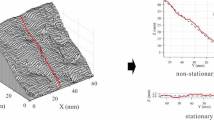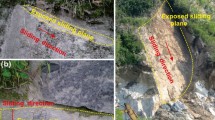Abstract
The rock joint roughness greatly affects the mechanical behaviors and permeability characteristics of rock mass. To accurately and effectively estimate the roughness of rock joints, an appropriate sampling interval is required to be specified during the point cloud collection using laser scanning systems and the roughness coefficient calculation. Firstly, seventeen point clouds of rock joints with sampling size ranging from 60×60 to 2000×2000 mm was collected using a terrestrial laser scanner in the field to investigate the effect of sampling size on the selection of the appropriate sampling interval. Then, a portable laser scanner was employed to acquire the dense point clouds of thirteen small-scale rock joint specimens, which have various roughness levels, to assess the influence of roughness level on the appropriate sampling interval. Furthermore, fitting analyses were performed to establish relationships between the appropriate sampling interval vs. sampling size and the appropriate sampling interval vs. roughness level, respectively. The results show that the curves of sampling interval vs. roughness coefficient followed a power distribution, and the inflection point with the maximum curvature could be regarded as the appropriate sampling interval; the appropriate sampling interval increased with the sampling size, while a negative correlation between the appropriate sampling interval and roughness level was observed. To facilitate the application of findings into practical engineering, a simplified workflow was provided to determine the appropriate sampling interval: 0.015×sampling size and 0.03×sampling size were recommended to be considered as appropriate sampling intervals for the rock joints with high-level and low-level roughness, respectively.
















Similar content being viewed by others
Data availability
The data and materials that support the findings of this study are available from the first and corresponding author, Yunfeng Ge and Huiming Tang, upon reasonable request.
Code availability
Codes that support the findings of this study are available from the first and corresponding author, Yunfeng Ge and Huiming Tang, upon reasonable request.
References
Alameda-Hernández P, Jiménez-Perálvarez J, Palenzuela JA, El Hamdouni R, Irigaray C, Cabrerizo MA, Chacón J (2014) Improvement of the JRC calculation using different parameters obtained through a new survey method applied to rock discontinuities. Rock Mech Rock Eng 47(6):2047–2060. https://doi.org/10.1007/s00603-013-0532-2
Bae DS, Kim KS, Koh YK, Kim JY (2011) Characterization of joint roughness in granite by applying the scan circle technique to images from a borehole televiewer. Rock Mech Rock Eng 44(4):497–504. https://doi.org/10.1007/s00603-011-0134-9
Barton N (1973) Review of a new shear-strength criterion for rock joints. Eng Geol 7(4):287–332. https://doi.org/10.1016/0013-7952(73)90013-6
Barton N, Choubey V (1977) The shear strength of rock joints in theory and practice. Rock Mech Rock Eng 10(1-2):1–54. https://doi.org/10.1007/BF01261801
Belem T, Souley M, Homand F (2007) Modeling surface roughness degradation of rock joint wall during monotonic and cyclic shearing. Acta Geotech 2(4):227–248. https://doi.org/10.1007/s11440-007-0039-7
Fardin N, Stephansson O, Jing L (2001) The scale dependence of rock joint surface roughness. Int J Rock Mech Min Sci 38(5):659–669. https://doi.org/10.1016/S1365-1609(01)00028-4
Feng Q, Fardin N, Jing L, Stephansson O (2003) A new method for in-situ non-contact roughness measurement of large rock fracture surfaces. Rock Mech Rock Eng 36(1):3–25. https://doi.org/10.1007/s00603-002-0033-1
Ge YF, Tang HM, Wang LQ, Xiong CR (2013) Error analysis of sampling spacing on roughness of rock joint based on three dimensional laser scanning testing. In: 47th US Rock Mechanics/Geomechanics Symposium. American Rock Mechanics Association, San Francisco, pp 2226–2237
Ge YF, Kulatilake PHSW, Tang HM, Xiong CR (2014) Investigation of natural rock joint roughness. Comput Geotech 55(1):290–305. https://doi.org/10.1016/j.compgeo.2013.09.015
Ge YF, Tang HM, Eldin MAME, Chen PY, Wang LQ, Wang JG (2015) A description for rock joint roughness based on terrestrial laser scanner and image analysis. Sci Rep 5:16999. https://doi.org/10.1038/srep16999
Ge YF, Tang HM, Eldin MAME, Wang LQ, Wu Q, Xiong CR (2017) Evolution process of natural rock joint roughness during direct shear tests. Int J Geomech 17(5):E4016013
Ge YF, Lin ZS, Tang HM, Zhao BB, Chen HZ, Xie ZG, Du B (2020) Investigation of the effects of nonstationary features on rock joint roughness using the laser scanning technique. Bull Eng Geol Environ 79:1–12. https://doi.org/10.1007/s10064-020-01754-6
Grasselli G (2001) Shear strength of rock joints based on quantified surface description (Thesis). EPFL, Lausanne.
Grasselli G, Egger P (2003) Constitutive law for the shear strength of rock joints based on three-dimensional surface parameters. Int J Rock Mech Min Sci 40(1):25–40. https://doi.org/10.1016/S1365-1609(02)00101-6
Han B, Zhang GB, Lan HX, Yan CG, Xu JB, Xu W (2020) Geometrical heterogeneity of the joint roughness coefficient revealed by 3D laser scanning. Eng Geol 265:105415. https://doi.org/10.1016/j.enggeo.2019.105415
Hong ES, Lee JS, Lee IM (2008) Underestimation of roughness in rough rock joints. Int J Numer Anal Methods Geomech 32(11):1385–1403. https://doi.org/10.1002/nag.678
International Society for Rock Mechanics (ISRM) (1978) Suggested methods for the quantitative description of discontinuities in rock masses. Int J Rock Mech Min Sci Geomech Abstr 15:319–368
Jang HS, Kang SS, Jang BA (2014) Determination of joint roughness coefficients using roughness parameters. Rock Mech Rock Eng 47(6):2061–2073
Jiang YJ, Li B, Tanabashi Y (2006) Estimating the relation between surface roughness and mechanical properties of rock joints. Int J Rock Mech Min Sci 43(6):837–846. https://doi.org/10.1016/j.ijrmms.2005.11.013
Jiang Q, Yang B, Yan F, Liu C, Shi YG, Li LF (2020) New method for characterizing the shear damage of natural rock joint based on 3D engraving and 3D scanning. Int J Geomech 20(2):06019022. https://doi.org/10.1061/(ASCE)GM.1943-5622.0001575
Kim DH, Gratchev I, Balasubramaniam A (2013) Determination of joint roughness coefficient (JRC) for slope stability analysis: a case study from the Gold Coast area, Australia. Landslides 10(5):657–664. https://doi.org/10.1007/s10346-013-0410-8
Kulatilake PHSW, Shou G, Huang TH, Morgan RM (1995) New peak shear strength criteria for anisotropic rock joints. Int J Rock Mech Min Sci Geomech Abstr 32(7):673–697. https://doi.org/10.1016/0148-9062(95)00022-9
Kulatilake PHSW, Balasingam P, Park J, Morgan RM (2006) Natural rock joint roughness quantification through fractal techniques. Geotech Geol Eng 24(5):1181–1202. https://doi.org/10.1007/s10706-005-1219-6
Kumar R, Verma AK (2016) Anisotropic shear behavior of rock joint replicas. Int J Rock Mech Min Sci 90:62–73. https://doi.org/10.1016/j.ijrmms.2016.10.005
Kumar R, Verma AK (2020) Corrections applied to direct shear results and development of modified Barton’s shear strength criterion for rock joints. Arab J Geosci 13:1019. https://doi.org/10.1007/s12517-020-06030-1
Kusumi H, Teraoka K, Nishida K (1997) Study on new formulation of shear strength for irregular rock joints. Int J Rock Mech Min Sci 34(3-4):1680–2147483647. https://doi.org/10.1016/s1365-1609(97)00029-4
Lee YH, Carr JR, Barr DJ, Haas CJ (1990) The fractal dimension as a measure of the roughness of rock discontinuity profiles. Int J Rock Mech Min Sci Geomech Abstr 27(6):453–464. https://doi.org/10.1016/0148-9062(90)90998-h
Lee SD, Lee CI, Park Y (1997) Characterization of joint profiles and their roughness parameters. Int J Rock Mech Min Sci 34(3-4):1740–17400000. https://doi.org/10.1016/s1365-1609(97)00083-x
Li Y, Wu W, Li B (2018) An analytical model for two-order asperity degradation of rock joints under constant normal stiffness conditions. Rock Mech Rock Eng 51(5):1431–1445. https://doi.org/10.1007/s00603-018-1405-5
Liu R, Li B, Jiang Y (2016) Critical hydraulic gradient for nonlinear flow through rock fracture networks: the roles of aperture, surface roughness, and number of intersections. Adv Water Resour 88:53–65
Liu Q, Tian Y, Liu D, Jiang Y (2017) Updates to JRC-JCS model for estimating the peak shear strength of rock joints based on quantified surface description. Eng Geol 228:282–300. https://doi.org/10.1016/j.enggeo.2017.08.020
Maerz NH, Franklin JA, Bennett CP (1990) Joint roughness measurement using shadow profilometry. Int J Rock Mech Min Sci Geomech Abstr 27(5):329–343. https://doi.org/10.1016/0148-9062(90)92708-M
Mah J, Samson C, McKinnon SD, Thibodeau D (2013) 3D laser imaging for surface roughness analysis. Int J Rock Mech Min Sci 58:111–117. https://doi.org/10.1016/j.ijrmms.2012.08.001
Patton FD (1966) Multiple modes of shear failure in rock. In: Proceedings of the 1st congress of the international society of rock mechanics, Lisbon, Portugal, September/October 1966, 1: 509-513.
Reeves MJ (1985) Rock surface roughness and frictional strength. Int J Rock Mech Min Sci Geomech Abstr 22(6):429–442. https://doi.org/10.1016/0148-9062(85)90007-5
Stigsson M, Ivars DM (2019) A novel conceptual approach to objectively determine JRC using fractal dimension and asperity distribution of mapped fracture traces. Rock Mech Rock Eng 52(4):1041–1054. https://doi.org/10.1007/s00603-018-1651-6
Sun SY, Li YC, Tang CA, Li B (2019) Dual fractal features of the surface roughness of natural rock joints. Chin J Rock Mech Eng 38(12):2502–2511
Tang HM, Ge YF, Wang LQ, Yuan Y, Huang L, Sun MJ (2012) Study on estimation method of rock mass discontinuity shear strength based on three-dimensional laser scanning and image technique. J Earth Sci 23(6):908–913 CNKI:SUN:ZDDY.0.2012-06-014
Tang HM, Wasowski J, Juang CH (2019) Geohazards in the three Gorges Reservoir Area, China–lessons learned from decades of research. Eng Geol 261:105267
Tatone BSA, Grasselli G (2010) A new 2D discontinuity roughness parameter and its correlation with JRC. Int J Rock Mech Min Sci 47(8):1391–1400. https://doi.org/10.1016/j.ijrmms.2010.06.006
Tatone BSA, Grasselli G (2013) An investigation of discontinuity roughness scale dependency using high-resolution surface measurements. Rock Mech Rock Eng 46(4):657–681. https://doi.org/10.1007/s00603-012-0294-2
Tse R, Cruden DM (1979) Estimating joint roughness coefficients. Int J Rock Mech Min Sci Geomech Abstr 16(5):303–307. https://doi.org/10.1016/0148-9062(79)90241-9
Ünlüsoy D, Süzen ML (2020) A new method for automated estimation of joint roughness coefficient for 2D surface profiles using power spectral density. Int J Rock Mech Min Sci 125:104156
Wang LQ, Wang CS, Khoshnevisan S, Ge YF, Sun ZH (2017) Determination of two-dimensional joint roughness coefficient using support vector regression and factor analysis. Eng Geol 231:238–251. https://doi.org/10.1016/j.enggeo.2017.09.010
Wang M, Wan W, Zhao YL (2020) Determination of joint roughness coefficient of 2D rock joint profile based on fractal dimension by using of the gene expression programming. Geotech Geol Eng 38(1):861–871. https://doi.org/10.1007/s10706-019-01070-1
Xie HP, Wang JA, Xie WH (1997) Fractal effects of surface roughness on the mechanical behavior of rock joints. Chaos, Solitons Fractals 8(2):221–252. https://doi.org/10.1016/s0960-0779(96)00050-1
Yang ZY, Lo SC, Di CC (2001) Reassessing the joint roughness coefficient (JRC) estimation using Z2. Rock Mech Rock Eng 34(3):243–251
Yang ZY, Taghichian A, Li WC (2010) Effect of asperity order on the shear response of three-dimensional joints by focusing on damage area. Int J Rock Mech Min Sci 47(6):1012–1026
Yong R, Ye J, Li B, Du SG (2018) Determining the maximum sampling interval in rock joint roughness measurements using Fourier series. Int J Rock Mech Min Sci 101:78–88. https://doi.org/10.1016/j.ijrmms.2017.11.008
Yu XB, Vayssade B (1991) Joint profiles and their roughness parameters. Int J Rock Mech Min Sci Geomech Abstr 28(4):333–336
Acknowledgements
Prof. Liangqing Wang and Dr. Changshuo Wang are acknowledged for their help in laboratory data collection. Special appreciation goes to the editor and two anonymous reviewers of this manuscript for their time and valuable comments.
Funding
This study was funded by the National Key R&D Program of China (No. 2017YFC1501303 and 2018YFC1507200) organized by the Ministry of Science and Technology of China and the general program (No. 42077264) organized by the National Natural Science Foundation of China.
Author information
Authors and Affiliations
Contributions
Conceptualization, Yunfeng Ge; methodology, Yunfeng Ge, Zishan Lin, and Binbin Zhao; formal analysis and investigation, Yunfeng Ge and Zishan Lin; writing (original draft preparation), Yunfeng Ge and Zishan Lin; writing (review and editing), Yunfeng Ge and Zishan Lin; funding acquisition, Huiming Tang; resources, Yunfeng Ge and Huiming Tang; supervision, Yunfeng Ge and Huiming Tang.
Corresponding author
Ethics declarations
Conflict of interest
The authors declare no competing interests.
Rights and permissions
About this article
Cite this article
Ge, Y., Lin, Z., Tang, H. et al. Estimation of the appropriate sampling interval for rock joints roughness using laser scanning. Bull Eng Geol Environ 80, 3569–3588 (2021). https://doi.org/10.1007/s10064-021-02162-0
Received:
Accepted:
Published:
Issue Date:
DOI: https://doi.org/10.1007/s10064-021-02162-0




